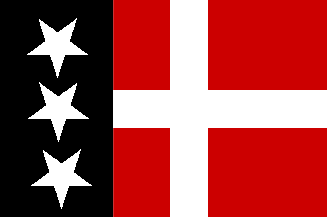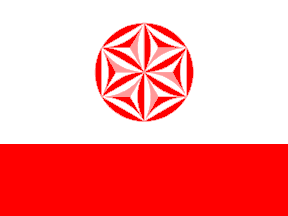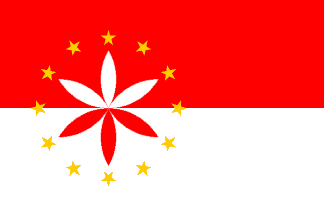 image by Ivan Sache
image by Ivan Sache
Last modified: 2021-08-24 by rob raeside
Keywords: arpitania movement | italy | cross | val daosta | savoy | aosta vulley | harpitanya |
Links: FOTW homepage |
search |
disclaimer and copyright |
write us |
mirrors
See also:
I found the flag of the "Movement Harpitanya", that
operates in Aosta Valley (Valle
d’Aosta) in Savoie.
Jaume Ollé, 19 February 1997
"Arpitany" is historical region of the Arpitanian
language (I suppose that it never formed a separate political
entity). This includes roughly the Aosta valley in Italy, Savoy
(both departments) in France, and Romandy (French speaking
Switzerland). Arpitanian, also known as Franco-provençal or Savoyan, is a
Latin language, making a "bridge" between
Occitan, Piemontese and French (aka Oil). As far as I know, it is
currently in a similar demographic situation as Occitan, i.e.,
still widely spoken, especially by older people in the
countryside, but regarded by most speakers to be
"patois", a lesser form of French. (That's why the
Italian government's move to declare French instead of
Arpitanian, as the official language of Val d'Aoste / Valle de
Aosta region left nobody satisfied...).
Naturally, there are intellectuals favouring the rehabilitation
of the language, its literary fledging, official protection and
use, dialectal standardization, speaker's consciousness and
terminology evolution. "Movement Harpitanya" might be
one of these organizations, I don't know. Their flag has clear
Savoyan connections, and I wouldn't be surprised at all it it
show to be blue instead of grey. As for the unusual spelling,
with an "H", I really never seen it that way, but it
might the result of a (recent?) orthographic reform.
Antonio Martins, 20 May 1999
Franco-provencal is different from patois and different from
the language usually spoken in the area. I quote parts of the
juicy book "Dictionnaire du Chablaisien" by A. Depraz,
a collection of words specifically used in the Chablais (northern
part of Savoy) and contiguous areas:
".The root of French language is common Latin - source of
Roman languages - used by Romans in all-day life and imposed in Gaule by the conquerors, the colons and the merchants. This
Latin quickly evolved in different spoken languages, in regional
varieties or dialects, or even in more localized varieties, the
patois. This led to the birth of the well-known oil and oc
languages, to which we must add Franco-Provençal. These three
languages were influenced, respectively, by Germanic inputs of
the Franks in North, Wisigoths in South, and Burgonds in our
region [Savoy]. In 1539, the order of Villers-Cotterets was
highly significant for the language history because French
instead of Latin was imposed as the official language to be used
for writing official documents. This French was the
"Francien", the dialect of Ile-de-France. At that time,
the Duchy of Savoy was completely fragmented and a great part of
it was occupied by the French. However, in all-day life,
patois was still spoken, a very high diversity of words and
pronunciations being established over the area. The official
language was progressively ruled by the French Academy and its
dictionary and good use definition, and French became an
idealized language. Beside this idealized language coexisted in
all regions and over centuries other spoken languages, the
patois. At that time, the rural population was bilingual
patois-French, and this lasted until the beginning of this
century. In this context of permanent exchange between two
languages were created the regional spoken languages, an all-day
French that everyone maintains from childhood [...] Concerning
Savoy, French had been official language long before the annexation
in 1860, and Savoy was always turned towards France.. Since XVIth
century, French had been the language of Court, bourgeois,
writers... For a great part of the population, the mother
language was one of the several patois created from
Franco-Provencal, but it was progressively replaced by a French
quite different from the "beau language", but rich of
multiple borrowed words and deformations."
I personally speak "regional French" from Savoy and
use several words that a Breton can not understand but which are
very familiar to a Romand Swiss (you find them in the wonderful
books of C.F. Ramuz and N. Bouvier, for instance). I don't use
them at purpose, for ethnic revendication but because they seem
evident to me. My maternal grand-parents were of urban origin and
did not speak a word of patois. My paternal grand-parents were of
rural origin but they spoke patois very infrequently. My
grand-father used it when he was bored by tourists (he was a
cobbler). The patois which is still spoken by very old people in
the mountains is different from the Franco-Provencal which is
often used in Val d'Aoste.
Ivan Sache, 20 May 1999
From Flaggenmitteilung: Harpitanya. The (agency?) that
represents the ethnic linguistic minorities in the Aosta valley
in Geneva and in Wallis, has a flag too: it has the emblem of
Savoy: in Red a White cross; to the hoist a vertical black bar,
in which on top of each other three white 5-pointed stars. The
symbolism of the flag is curious: red and white signify the
colors of the Aosta Valley (the center of the movement); red
means the basse (?). The cross symbolizes an old megalithic sign.
Jaume Ollé (translated by Jarig Bakker), 20
September 1999
"Moveman Harpitanya" (Francophone Alpine
separatists) - Swiss/French/Italian region - vertical stripe at
hoist black. IMHO The black stripe seems more logical by
reference to the Valle d'Aosta traditional
flag .
This flag is listed under number 43 at the chart Flags of
Aspirant Peoples [asp].
Ivan Sache, 19 September 1999
The vertical stripe in the Harpitanya flag must be black
according to its creator and political leader Joze' Harrieta.
Flag was designed by Harrieta in the summer of 1970. The three
white stars mean the three parts that is dividing the historical
Harpitanya (Swiss-French-Italian).
Jaume Ollé , 9 March 2001
Please note that Arpitania (local spelling preferred by
arpitanists: Harpitanya) is a linguistic territory, it never
existed as an independent entity: It indeed largely corresponds
to historical Savoy (hence the Savoyan cross on the Arpitanian
Movement flag), but Savoy was not an Arpitanian national state
(actually Savoy disappeared more or less by the same time when
the very concept of national states arouse).
Antonio Martins, 12 March 2001
Well, it seems that Savoy should be included two times in this
"Arpitania" - which, by the way, has strictly no
audience there. Haute-Savoie and Savoie (there is no
"Basse-Savoie", Low Savoy) are the two French
departements made after the incorporation of Savoy to France in
1865. Note that the independentists of the Savoisian League
reject this division of historical Savoy and would probably not
agree with the Great Arpitanians. Chablais, Faucigny and Genevois
were the three traditional provinces of what is now the
departement of Haute-Savoie. Tarentaise, Maurienne, and Savoie
Propre (I suppose this is Pelvia) were the three traditional
provinces of what is now the departement of Savoie.
The term Hiota (with a long "o" and the final
"a" nearly dropped) is used colloquially to design
Haute-Savoie. Franco-Provencal is extinct there but a lot of
local words have survived. I call "local words" those
words common for me but not understood by my colleagues from
other parts of France.
Ivan Sache, 18 April 2002
I recently returned from a short stay in southern Burgundy and
southern French Jura and noticed that many town names were
strongly reminiscent of Francoprovencal, a.k.a Arpitan. The
Panarpitan flag seems to be the most widely recognized among
Arpitan speakers (there must be very few left, if any, in the
region I visited and Arpitan is receding even in Aosta city while
remaining strong in neighbouring valleys). The Francoprovencal
wikipedia website also displays another one which is obviously a
mix of Valdotan and Savoy flags <frp.wikipedia.org>..
On the forum of the arpitania.ch website at <arpitania.forumactif.com>,
I found a discussion about Arpitan flags. Apart from the proposal
posted at the beginning of the discussion, there is some debate
about the 6-pointed symbol which seems to be an "Alpine
sun" also known as "rozoun" in Arpitan,
"rozon" in regional French, "rossone" in
Italian. Someone argues that it is more Roman than Arpitan,
others retort that the symbol can be found on Burgundian
artefacts and is indeed widespread and popular throughout
Arpitania. The temporary conclusion is that no flag is
unanimously recognized by Arpitan speakers as being
"the" flag of Arpitania. One of the contributors to
that Arpitania forum even questions the usefulness of such a
flag.
Thanh-Tam Le, 11 and 12 August 2006
 image by António Martins-Tuválkin, 11 September 2006
image by António Martins-Tuválkin, 11 September 2006
Here is the flag of the Great Arpitania (dated 1995) - white
and red, whith the Sun of the Alps on the red. The flag of the
Little Arpitania appears on top, but it includes a number of
mistakes. It dates from "1972", not from 1970, the name
of its creator must be spelled "Josèf Hanriet", not
Jozé Harrieta, and that of his mouvement "Mouvament
Arpitania" (without H), not Moveman Harpitanya. Little
Arpitania (Petita Arpitania in the Francoproveçal language) is
formed by the valleys of Chablais (Le Chablès), Faucigny
(Fôcegny), Genevois (Genevês), High Savoy (Hiôta-Savouè), Low
Savoy (Bâssa-Savouè), Tarentaise (La Tarantèsa), Maurienne
(Môrièna) and Pelvie (Pelvia) in France; Valais (Valês) and
Pays de Bex (Bexê) in Switzerland; and Val d'Aosta (Vâl
d'Aoutha), Valdesia (Vâldèsia) and Canavese (Canavês) in
Italy. Great Arpitania (Granta Arpitania) also includes Lyonnais
(Lyonês), a part of Burgondy (Borgogne) and of the Franche-Comte
(Franche-Comtât) and parts of the rest of Dauphine (Dôfenâ)
and of the Romand Switzerland (Romandie).
Name withheld by request, 18 April 2002
The flag mentioned as being that of "Great
Arpitania" actually is a simplified version of that of
Effepi, an association of the Franco-Provencal (Arpitan) minority
in Piedmont. A larger and more detailed image can be found on
their website: <www.francoprovenzale.it>.
This is not meant to be a flag for all Arpitans
and the logo is copyrighted.
Thanh-Tam Le, 12 August 2006
EFFEPI is an association which is concern about valorisation
of the francoprovencale language and for saving the culture of
Francoprovenzale in the Region of Piedmonte in Italy.
Valentin Poposki, 9 September 2006
Considering the map on the website's index page,
this entity seems to recognize and promote the franco-provençal
language as a whole, in Switzerland, Italy and France, but
the flag seems to symbolize this particular organization, not the
language as a whole nor its territory.
The logo was created in 1981, the flag was firts hoisted in 1997,
according to this website. It is a horizontal unequal bicolor of
white over red, with apparent specs 3:4 = (2+1):4 with the logo,
with diam. approx. half of the flag's height, centered on the
upper stripe. This site does not mention the evident symbolism
(and agenda?) connection with
Lega Nord. The logo seems to be monochrome (red on white).
António Martins-Tuválkin, 11 September 2006
See also:
 image by Thanh-Tam Le, 11 August 2006
image by Thanh-Tam Le, 11 August 2006
On French Wikipedia, there is a larger image of the Panarpitan
flag at <fr.wikipedia.org>.
See also <arpitania.forumactif.com>.
Thanh-Tam Le, 12 August 2006